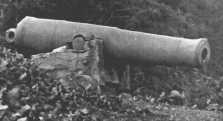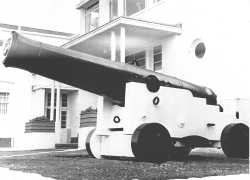|
| |
RML 64-pr 71-cwt
With the advent of rifled guns around 1860 Ordnance authorities sought a means of converting the large numbers of smooth-bore muzzle-loaders in stock to rifled pieces. Unfortunately these were all made of cast iron which would not stand the additional stresses rifling involved without strengthening. In 1863 Major (later Sir William) Palliser of the 16th Hussars came up with a solution which worked, and was adopted in Britain as well as some other countries, notably the United States. His method of conversion, shown in Fig. 2, was as follows: the cast iron gun was bored out, a loose barrel of coiled wrought iron strengthened at the breech end by a coiled 'B' tube and closed by a screw cap was fitted into the gun as a close mechanical fit. The barrel was secured by a collar screwed into the muzzle and prevented from turning by a plug screwed through the gun near the breech. It was then rifled with three grooves on the Woolwich system (copied from the French), after which a few heavy proof rounds were fired to expand the barrel into close contact with the exterior case. A tell-tale hole provided to indicate any failure is generally found under the cascable, the 'knob' in rear of the breech.
Palliser's system saw limited service in coast and naval roles, as the old SBML guns converted were too short to achieve the longer ranges being demanded in the 1870s. Conversions were limited to 64-prs and heavier. The New Zealand Government bought eight of them in 1885 -after they had been declared obsolete by the Royal Navy in 1879. No doubt they got them cheap. | |
|
|
|
|
When first received in New Zealand in 1885 the guns were installed in forts ostensibly for practice purposes but were used solely for saluting. They were mounted on four-truck (four-wheel) wooden sea-service carriages as originally used in the Royal Navy and depicted in Figs 3 and 4. Left exposed to the weather they quickly deteriorated. Eventually two of the four guns from Fort Victoria were obtained by the RNZN, the carriages were restored by the Dockyard and the complete equipments placed outside the wardroom, HMNZS Philomel,as shown in Fig. 4. What happened to the other two no one seems to know. Besides the gun outside the Army Museum depicted in Fig. 1, two other identical pieces are situated within Waiouru Camp, opposite the headquarters building. Army restorers seem to have tired before finishing the job for none of the Waiouru guns has axles or wheels. The designation 'shell gun' (see Fig. 1 and detail) is of interest. During the smooth-bore era guns normally fired shot and howitzers shell. The naval 8-inch was an exception. WL Ruffell Guns at Waiouru | Guns around New Zealand | More equipments | Home | |



